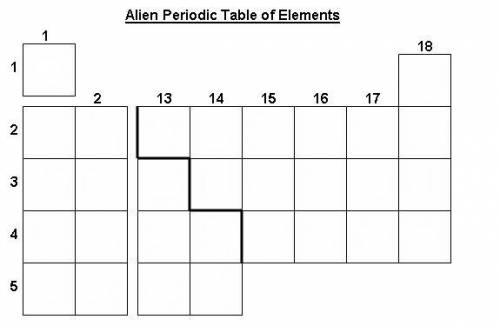
Biology, 06.09.2021 02:20 RyannLambertt9722
The noble gases are sondal (So), nobble (N), leptum (L), and drogon (Dr). Among these gases, nobble has the greatest atomic mass and sondal the least. Drogon is lighter than leptum.
The metal elements in the most reactive group are bruan (Bn), byzmium (By), wondit (Wo), and xakbill (X). Among these metals, wondit has the lowest atomic mass. Xakbill is in the same period as nobble.
Tapstrom (Tp), romulon (Ro), and kritt (Kt) are nonmetals whose atoms typically gain or share one electron. Romulon is in the same period as xakbill and nobble.
The metalloids are effsit (E), hioo (Hi), terrabim (Tm), and syssyss (Ss). Among these metalloids, syssyss has the greatest atomic mass and effsit the least. Hioo and terrabim are in Group 14. Terrabim has more protons than hioo. Yahtza (Yz) touches the zigzag line, but it's a metal, not a metalloid.
The lightest element is iostrom (Io). The heaviest element in the group of 30 elements is elephantum (El). The most chemically active nonmetal is tapstrom. Kritt reacts with byzmium to form table salt.
Begone (Bg) has only four protons.
Flixmit (Fx) is important in the chemistry of life. It forms compounds made of long chains of atoms. Rix (Rx) and dortador (Do) are metals in the fourth period, and rix is less reactive than dortador.
Moonstype (M), golby (G), and syssyss are in Group 15. Golby has fewer electrons than moonstype.
Upra (Up), oziim (Oz), and nuotey (Nu) gain two electrons each when they react. Nuotey has two electron shells and has the same properties as a gas found in Earth’s atmosphere. Oziim has a lower atomic number than upra.
Faltuum (Fa) has 49 electrons. Zippr (Z) and picon (Pi) lose two electrons each when they react. Zippr is used to make lightweight alloys.


Answers: 2
Another question on Biology


Biology, 22.06.2019 05:00
Dna. we have heard that we are a product of our dna. but where is it? how do we "get" our dna? it is passed to us, from our parents, but in what form? several vocabulary words associated with inheritance are used interchangeably and sometimes, incorrectly. let's see if you can clear this up for someone just learning about inheritance and cell structure.
Answers: 2

Biology, 22.06.2019 05:30
Plants consume most of their carbon from a. the soil b. the water c. the roots d. the air
Answers: 2

Biology, 22.06.2019 12:00
Refer to the family pedigree shown here. in generation i, one parent is affected by the gene mutation and one parent isn't. in generation ii, all three children are affected by the gene mutation. what can you conclude about this gene mutation? a. all children born in future generations will be affected by this disorder. b. this gene mutation is a dominant disorder. c. this gene mutation is a recessive disorder. d. the generation i mother is a carrier of this gene mutation.
Answers: 2
You know the right answer?
The noble gases are sondal (So), nobble (N), leptum (L), and drogon (Dr). Among these gases, nobble...
Questions


History, 21.12.2019 03:31

Mathematics, 21.12.2019 03:31

Arts, 21.12.2019 03:31


Mathematics, 21.12.2019 03:31

Mathematics, 21.12.2019 03:31




Mathematics, 21.12.2019 03:31


English, 21.12.2019 03:31

Mathematics, 21.12.2019 03:31

Mathematics, 21.12.2019 03:31

Health, 21.12.2019 03:31






